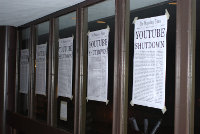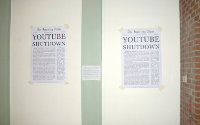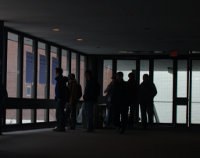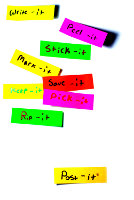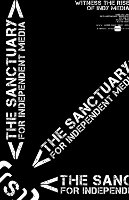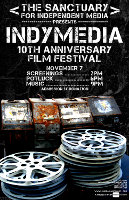The Congress shall have power to promote the Progress of Science and useful Arts, by securing for limited Times to Authors and Inventors the Exclusive Right to their respective Writings and Discoveries.
This is Article I, Section 8, Clause 8 of the U.S Constitution, also known as the Copyright Clause. It was meant to
promote creativity by giving the author/artist/inventor certain legal protections and ownership (
for a limited time) over their creations. These exclusive rights were intended for the creator, not the publisher, and intended to promote progress and creativity, not to enrich the publisher or reward the creator. This sounds wonderful, but the current regulations couldn't be farther from that ideal.
Originally, the copyright term, for regular works and works for hire, was
14 years with the one-time chance to extend it another 14 years. But over time, the period for regular works has been extended to
70 years after the author dies, and works for hire have been extended to
120 years after creation or 90 years after publication (which ever is shorter). This creates a number of problems. If an author/owner disappears (or no longer exists), then their works essentially become lost because no one can copy or distribute them. This also gives corporations and publishers long-term monopolies over large amounts of content.
There are also problems with copyright laws being outdated. For instance, something is classified as
public display if:
- there is more than 1 TV per room
- the TV is larger than 54 inches
- the size of the viewing area is larger 2000 square feet
- there are more than 4 loudspeakers per room (or more than 6 total)
There's more criteria, but I think you get the idea. That probably means your typical modern home entertainment system is illegal if you watch something with non-family members.
Then, of course, there is the Digital Millennium Copyright Act (
DMCA), which makes criminal the production and use of any tool that could
potentially be used to circumvent any
DRM. Not to mention that it makes any kind of digital copyright infringement a
felony offense. Trivial infractions (such as mash-ups, AMVs, or filming/recording while a protected song happens to be playing on the radio), even if unintentional, are still subject to the DMCA.
The real kicker are the Statutory damages, which can currently be up to
$1 million per infringement. That's a wealth of money just waiting to be exploited by content owners, and at this point, it's getting really hard, to go about your daily life with out some sort of copyright infringement.
Currently, service providers (ISPs, web hosts, email providers, entertainment providers like YouTube, content/information providers like Wikipedia or news sites, etc...) have some protection against the DMCA under the Online Copyright Infringement Liability Limitation Act (
OCILLA). However, to be eligible, there are a number of provisions that must be met, and the service providers must comply with DMCA take-down requests in an expeditious manor. If providers don't comply with the OCILLA, they can be held liable for damages.
Under the terms of the OCILLA, providers aren't required to police their content; finding infringing material and sending notices rests solely with the content owner. However, with "Web 2.0" services being largely driven by user contributed content, some groups are trying to put more pressures on providers to share the burden. So who knows how long the OCILLA will last.
I don't know about you, but this doesn't look like it's remotely trying to protect or foster creativity. If anything, it's just giving corporations bigger and better tools to keep their wallets fat.
So, with this project, I wanted to comment on how broken-ness copyright law in a satirical way. So I constructed a mock newspaper front page detailing what the downfall of YouTube could possibly be like. In part, this project was inspired by the works that
The Yes Men and the
Billboard Liberation Front have done.
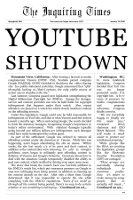
^ click to embiggen ^
I then printed out a number of posters and installed them in a number of locations around campus.
The next day I watched one of the installations for about 15 minutes. During that time, at least 10 people stayed long enough to read through the poster and explanation. Another 20 stayed long enough to give it a good, serious look. At the very least, it caught the attention of most of the people that walked by it.
I walked by it a number of times during the next day, and I was quite pleased to usually see a group of people reading the posters. And apparently someone liked them enough to take one.
While I'm not sure what the audience took away from the posters, at least they got a lot of attention. So just that alone surpassed my expectations of the project. So overall I'm quite happy.
If you want to learn more about copyright in the digital world, or want to get involved, a good place to start is the
Electronic Frontier Foundation


